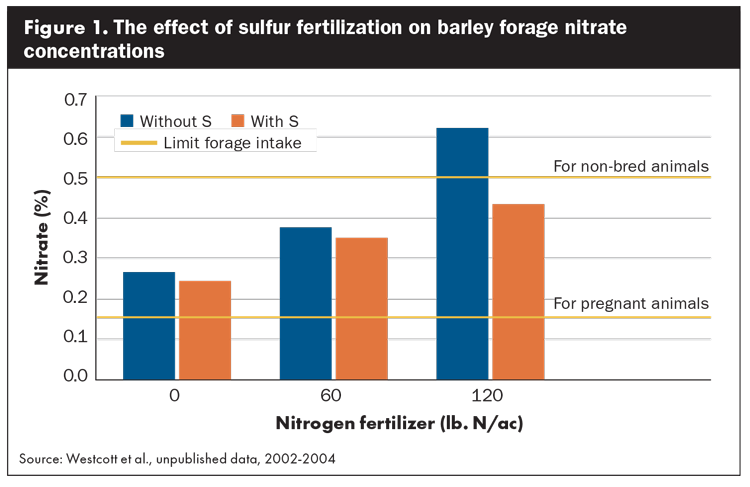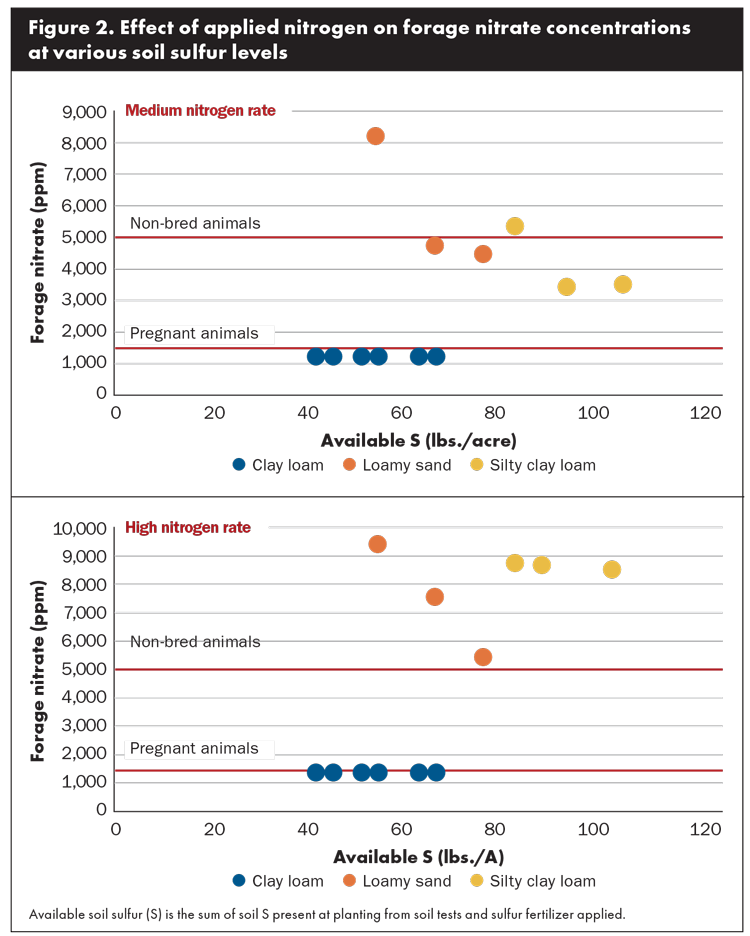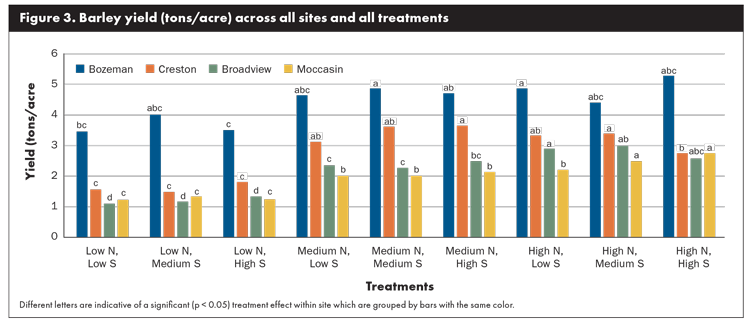
Montana livestock producers typically require two to four months of stored feed to overwinter cattle, and this is generally the largest annual variable cost to ranches. As a result, slight improvements to cropping systems can provide significant reductions in feed expenditures. Of Montana’s 2.6 million acres of hay production under rain-fed production, 90% of it is fed back to livestock on the farm or ranch, emphasizing the importance of hay quality.
Of the hay crops suited for a short growing season and rain-fed production, annual cereal forages are a popular choice to stock forage inventories. These forages, such as barley, wheat, oats, and triticale, are commonly grown as forage while renovating aging perennial stands or as an emergency forage source during drought.
A frequent problem
Annual cereal forages are not without challenges, the most common being toxic nitrate accumulation that can cause late-term abortions, reduce conception rates, or cause livestock death. Sulfur fertilization to cereal hay crops has been proposed as a potential solution to this problem based on unpublished data from two western Montana research stations where variable nitrogen and sulfur fertilizer rates were applied to forage barley (Figure 1).

The issue that still exists for Montana soils is determining a quantifiable relationship between soil test sulfur, subsequent plant uptake, and forage yield response. The correlation between plant tissue sulfur and a yield response is understood, and ratios exist to establish deficiency levels, but they do not provide a proactive approach to managing nitrate accumulation.
Looking for answers
Due to the need for a solution to mitigating high levels of nitrate accumulation in annual cereal forages, four sites across Montana were selected to grow “Lavina” forage barley. Nitrogen rates were determined based on Montana State University recommendations and soil test nitrogen for each location. Some of the chosen rates were higher than what might be expected for a typical yield in these areas of Montana; this was to elicit a nitrate accumulation response. Sulfur rates applied were 0, 10, and 20 pounds of sulfur per acre. At this time, the data presented is only from the first season, so scientific conclusions based on these data are not advised.

The four sites of this study vary in soil characteristics. The Bozeman location is a deep, clay loam — silty clay loam soil with organic matter percentages ranging from 3% to 6.9%. In Broadview, the soil is a shallow, shale soil with organic matter percentages of 2.2% to 2.3%. The Moccasin site is a shallow, clay loam soil with organic matter percentages ranging from 1.7% to 5.5%, while the Creston site is a loamy sand soil with organic matter percentages ranging from 0.9% to 2.1%.
At Creston (loamy sand), the data was variable with the 10 and 20 pounds per acre sulfur rates reducing nitrate for the medium (recommended) and high (1.5 times the recommended) nitrogen treatments (Figure 2). Medium nitrogen and high sulfur yielded more than high nitrogen and sulfur and had lower forage nitrate concentrations (Figure 3).
Interestingly, at Bozeman, the silty clay loam site with deep soils and high rainfall, forage nitrate was high in several treatments (Figure 2). We achieved a 5 tons per acre yield with only 40 pounds of nitrogen per acre applied at this site (Figure 3). Theoretically, there should not have been high levels of accumulated nitrate. These results suggest that either there was deep soil nitrate unaccounted for in our soil samples, or that the hot, dry conditions before harvest had an influence.

At the clay loam sites of Moccasin and Broadview, forage nitrate levels did not accumulate to levels considered dangerous to livestock health, with all levels less than 1,500 parts per million (ppm), which put these sites in the lowest risk category (Figure 2). One observation is that yields were higher than anticipated at these two sites, so nitrogen fertilization levels were likely below optimum (Figure 3). This may have contributed to low plant accumulation of nitrates at these two sites. Both Moccasin and Broadview also did not experience drought conditions for the entirety of the growing season, contributing to the previously mentioned higher yields and less adverse growing conditions than normal.
These results suggest that boosting nitrogen fertilizer to 1.5 times above the recommended rates may increase forage nitrate but not yield, while maintaining the recommended nitrogen rate with the addition of 10 pounds per acre of sulfur may reduce nitrate accumulations to less toxic levels. It may also be that loamy sand-textured soils might be subject to a more drastic response to additions of sulfur, as much of the soil sulfur has been leached due to its coarse soil texture. Deeper soils may have some nitrate and sulfate that are not captured during soil sampling, and this may be responsible for the less drastic reductions we found with additions of both sulfur and nitrogen fertilizers.
During the current growing season, nitrogen fertilizer rates were raised to account for the yield potential of our sites as opposed to yield goals. We hoped for and are experiencing a drier growing season than 2023, which will make nitrate accumulations more likely. Stay tuned.
This article appeared in the August/September 2024 issue of Hay & Forage Grower on pages 18-19.
Not a subscriber?Click to get the print magazine.

